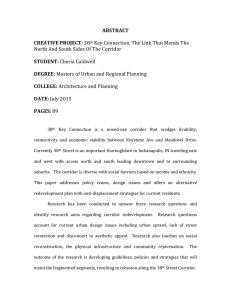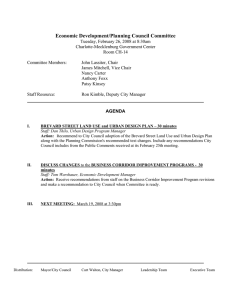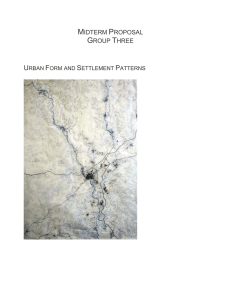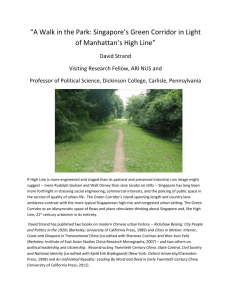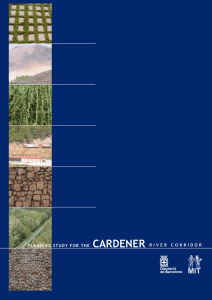Document 13640208
advertisement
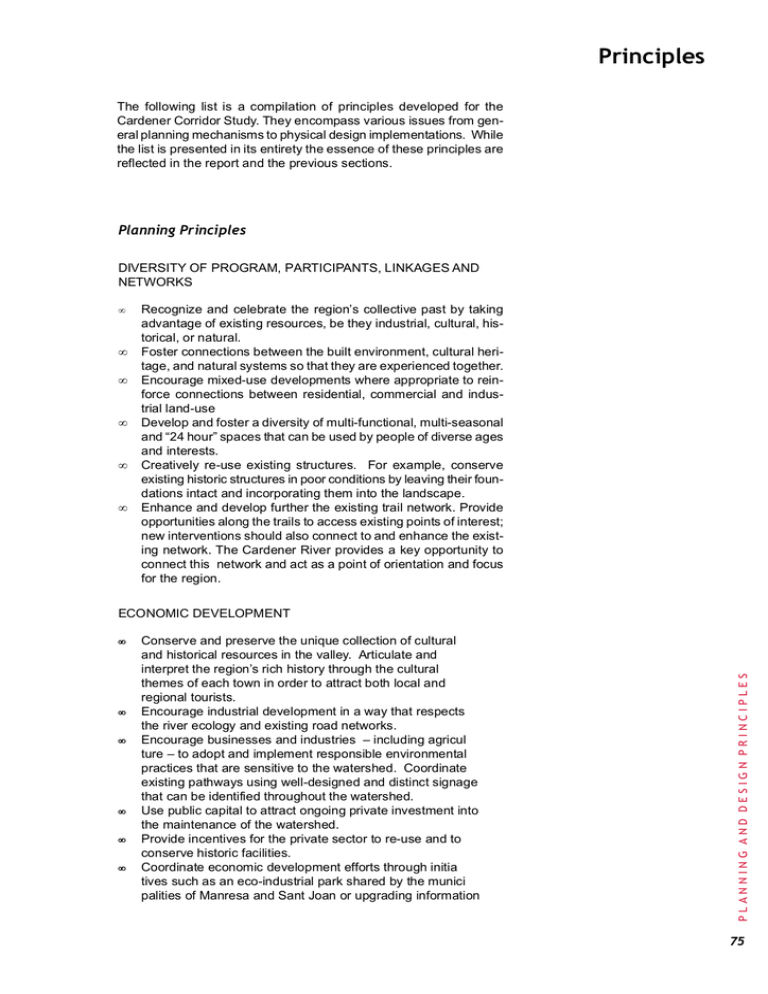
Principles The following list is a compilation of principles developed for the Cardener Corridor Study. They encompass various issues from gen­ eral planning mechanisms to physical design implementations. While the list is presented in its entirety the essence of these principles are reflected in the report and the previous sections. Planning Principles DIVERSITY OF PROGRAM, PARTICIPANTS, LINKAGES AND NETWORKS • • • • • • Recognize and celebrate the region’s collective past by taking advantage of existing resources, be they industrial, cultural, his­ torical, or natural. Foster connections between the built environment, cultural heri­ tage, and natural systems so that they are experienced together. Encourage mixed-use developments where appropriate to reinforce connections between residential, commercial and indus­ trial land-use Develop and foster a diversity of multi-functional, multi-seasonal and “24 hour” spaces that can be used by people of diverse ages and interests. Creatively re-use existing structures. For example, conserve existing historic structures in poor conditions by leaving their foun­ dations intact and incorporating them into the landscape. Enhance and develop further the existing trail network. Provide opportunities along the trails to access existing points of interest; new interventions should also connect to and enhance the exist­ ing network. The Cardener River provides a key opportunity to connect this network and act as a point of orientation and focus for the region. •• •• •• •• •• •• Conserve and preserve the unique collection of cultural and historical resources in the valley. Articulate and interpret the region’s rich history through the cultural themes of each town in order to attract both local and regional tourists. Encourage industrial development in a way that respects the river ecology and existing road networks. Encourage businesses and industries – including agricul ture – to adopt and implement responsible environmental practices that are sensitive to the watershed. Coordinate existing pathways using well-designed and distinct signage that can be identified throughout the watershed. Use public capital to attract ongoing private investment into the maintenance of the watershed. Provide incentives for the private sector to re-use and to conserve historic facilities. Coordinate economic development efforts through initia tives such as an eco-industrial park shared by the munici palities of Manresa and Sant Joan or upgrading information PLANNING AND DESIGN PRINCIPLES ECONOMIC DEVELOPMENT 75 • • • • • • • technology along the Cardener to revitalize existing industries. Encourage sustainable businesses to locate in industrial zones. For example: Businesses that promote renewable energy use, such as solar photovoltaic manufacturing industries. Agriculture and livestock-based production such as food and dairy industries, bio-gas production, and pharmaceuticals Organic agriculture production using greenhouses and/or hydroponic production Recycling and re-use industries Develop and encourage creative financing to accomplish public goals. Raise regional awareness of the river corridor through strategic vi­ sual and physical interventions and advertisements to attract tourism (if desired) ECOLOGY AND ENVIRONMENTAL SENSITIVITY •• • • • • • • • • • • • •• 76 Land-use planning and development in the Cardener river corridor should adopt a watershed approach which adheres to natural, rather than political boundaries for regional planning. Manage and mitigate water quantity and quality in the Cardener wa­ tershed in order to support a healthy ecosystem. Natural resource and land management should balance the need for accessibility with the need for conservation along the Cardener River corridor, given the region’s exemplary opportunities for recre­ ation and tourism. Particular attention should be given to those ar­ eas under greatest development pressure. Explore a diversity of options for protecting sensitive environmental areas, including easements, zoning, set-asides, public-private land trusts, agricultural cooperatives, and economic incentives and poli­ cies. Limit development in critical watershed areas, particularly on the (northern) west side of the Cardener along Callús and Súria. Review new developments in order to identify potential negative im­ pacts on the local ecology. Furthermore, initiatives should contrib­ ute or be sensitive to the ecological restoration of the region. Work cooperatively with farmers, industry and adjacent communi­ ties to explore solutions to agricultural and industrial waste chal­ lenges, such as waste disposal, management and elimination. Ensure that construction of new roads within 30 meters of a water body do not interfere with the natural systems of the water’s edge, and avoid erosion of the land, destruction of wildlife habitat, or un­ necessary removal of native flora. New routes should be designed to catch and (passively) filter run-off from adjacent industries or ag­ ricultural uses. Conserve the existing topography and native vegetation when build­ ing new developments and/or rehabilitating existing ones. Improve the channel network and natural riverbanks by re-grading where necessary. Design parking facilities to allow on-site drainage. Encourage use of high quality materials and adequate vegetation for shading when integrating parking into this sensitive environment. Siting of parking facilities should take into consideration not only the minimization of access roads necessary to serve them, but also the view from public rights-of-way. Re-vegetate riparian area and uplands with native species to im­ prove the valley’s bio-diversity. Develop a local nursery with trained staff, to supervise native habitat restoration. Encourage community involvement through a volun- • • teer network and complementary curriculums in public schools. Develop infrastructure that mirrors the region’s goals for environ­ mental sustainability: Initiate, develop and maintain a phased regional public education campaign to promote the concept of watersheds and environmental sustainability. This campaign should draw upon the river itself as an interactive learning tool. Its condition can be monitored both by simple observation techniques and scientific methods. •• • • • • • • • • • • • • • Reuse historic and cultural buildings for a variety of contemporary activities. For example: hotels; educational institutions; housing; research and development facilities, production, and office space – while maintaining the design and landscape character of their his­ toric setting. Encourage in-fill of housing and commercial activities within the ex­ isting urban fabric and discourage expansion of the urban built bound­ ary. Protect strategic areas of agricultural land (“horts”) for self-sustain­ ing farming. Create a multi-city master plan that defines land use specifically along river corridor. Remain sensitive to the scale of growth appropriate to the existing infrastructure. Connect existing public spaces to new access routes (particularly along the Cardener River). Determine targets for growth and wherever possible, preserve val­ ued agricultural land. Design new industrial areas to contribute to the ecological integrity of the region – use high quality materials and pay attention to the scale of the surrounding environment. Preserve community character of the horts and provide support for protecting them. This agricultural land serves an important multifunctional purpose for local communities and forms a unique piece of the urban fabric along the corridor. Discourage building new facilities in the floodplain of the river. Require new facilities located within 30 meters of water body to treat all wastewater in-house (ie not released into their land through sep­ tic beds) and provide a second in-house water filtration facility to ensure the cleaning of the adjacent water body. New facilities lo­ cated 30-100 meters from a water body must treat all wastewater inhouse. Require local communities to consider the river in their master plans. Coordinate zoning across municipalities in order to concentrate growth in regionally beneficial and appropriate areas and to ensure continuity of green space. Coordinate regional industrial development between Manresa, Sant Joan and Callús. Consider financial policies and subsidies which would reflect and support the land use goals of the region. For example, implement revenue-sharing across municipalities and provide tax incentives for responsible planning. TRANSPORTATION • Consider opening the existing freight rail lines to passenger traffic at targeted times of day and year. Times between these targeted ser­ vices could be reserved as part of tourist packages stopping at each PLANNING AND DESIGN PRINCIPLES LAND-USE AND GROWTH 77 • • • • • • • • town to engage new and existing cultural and recreational facilities. Consider providing a perimeter bus connection from Manresa’s ex­ isting passenger rail station serving Barcelona to a future passen­ ger rail station in Suria in order to serve the northern communities. Develop multi-modal transportation options for commuters, residents and visitors along the Cardener. Integrate a recreational and interpretive route(s) that would be available to experience the environment by bike, on foot, by rail, and by car. Coordinate plans for new highways with the Generalitat de Barcelona according to local residential and commercial development patterns. Ensure that expanded transportation networks continue to connect individual settlements within and along the river valley. Implement a hierarchical, uniform signage system that reflects the uniqueness of the Cardener River corridor and allows for easy navi­ gation of the region by residents and visitors. Develop a multi-layer path system that provides for traffic on foot, bicycle, and automobile. Establish a system of trails and scenic opportunities that cut across the valley in directions that are perpendicular to the flow of the river. COMMUNICATION AND EDUCATION •• • • • • • • • • • • Integrate a network of interpretive sites in the corridor utilizing both existing structure and outdoor locations. These would pull together the overall story of the place, and play a formal education role, as field learning venues for local schools. Initiate experiential watershed education programs through the school systems. Form partnerships with regional schools to include them in environ­ mental and cultural heritage preservation efforts. Educate local community members through formal and informal measures: through programs at the future EcoCenter and through educational signs along the river path. Gather public involvement and support through annual events and public meetings in order to ensure the success of any planning inter­ vention. Form a local Non-Governmental Organization to administer and or­ ganize river walk and inter-community events. Encourage a diversity of organizations (fishing organizations, hiking clubs, biking groups) to participate in the process of habitat preser­ vation and management. Educate the valley residents and visitors about how they can reduce non-point pollution and use the river respectfully. Use existing festivals and town events to strengthen community iden­ tity and begin new traditions that tie together identity of corridor as a whole. Integrate educational programs with the University in Catalunya’s research objectives. Commission artists and designers for infrastructure and land improve­ ments. General Design Guidelines •• • • • 78 Transform riverbanks into green corridors in each city and relate them to adjacent urban developments. Build additional pedestrian bridges across the Cardener to connect uses on either side. Improve pedestrian access on existing bridges through reconstruc­ tion or renovation. Provide consistent interpretive and directional signage throughout the Corridor. • • • • • • • • • • • • • • • • • • • • Encourage design that reflects the vernacular style of the region. Parking surfaces should be permeable and reflect the microclimate. Provide attractive and sensitive pedestrian lighting in identified loca­ tions that connect to urban activities along the river. Integrate paths into the infrastructure and circulation pattern for com­ muters. Integrate public art into locations along the river corridor. The natural banks of the river should be maintained and enhanced to promote vegetation and wildlife habitat. Views of the river should be provided at regular intervals by the se­ lective thinning of vegetation at key locations. Enhance way finding (signs, design of intersections, vistas) in the river corridor. Establish design criteria at the regional level for the design of signage for transportation networks, cultural resources and historic landmarks, other sites of significance New buildings facing the river corridor should address the river with facades commensurate with the scale and significance of the site. The character of interventions, except in exceptional circumstances, should compliment the character of the surrounding landscape in terms of materials, scale and typology. Particularly, the scale of the intervention should be appropriate to the scale of the The character of paths should respond to the mode of transportation envisioned for each particular segment, taking into account travel times and distances between significant points of interest or urban centers. Incorporate the following elements into design of public spaces (where appropriate): water and soil remediation, river bank re-grading, community gardens, walking and bicycle trails, playing fields, new and recycled industrial buildings, site-specific art, dem­ onstration and teaching centers of various sizes, discovery exhibits, facilities for maintaining the space, visitor centers, event halls, and cafes. Construct stream bank restoration along the existing floodplain and in areas indicated by the Green River Plan for various scenic and ecological purposes, such as to filter agriculture runoff, to prevent erosion or scouring of the foot of hill’s ridge, to prevent sediment runoff from gravel factory and potash mines, to treat industrial and municipal discharges in some sections, to enhance or to create fish habitats. Continuous trails/paths should follow the river’s edge at either the top of the bank, the toe of the slope, the lower ridges or both. Paths must be connected to provide “looping” Access- Overlooks, steps down to the water, should be placed at various locations along the river to mark points of access. The primary river edge pathway should be constructed with a typical width of 3-4 meters. No new buildings will be constructed within 50 m along the river corridor, with the possible exception of small water related activities. Vegetation along the natural riverbanks should be selectively cleared and enhanced with additional plants that will prevent erosion and promote wildlife, while still allowing some views of the water. A zone of natural wetland vegetation along the water’s edge should be preserved and recreated to stabilize the banks. On-street parallel parking should be considered for roads that bor­ der the river in order to encourage use and reduce traffic speeds. Continuous rows of trees are recommended along both sides of the streets for roadways that parallel the river and that lead to the river and/or to river bridges. Streetscape details should be consistent, including lighting, signage, materials, and furnishings. No new surface parking lots will be developed along the river; exist­ ing lots will be improved to remedy for water runoff and enhanced with planting. PLANNING AND DESIGN PRINCIPLES • 79 • 80 Coordination of existing pathways should involve unique, well-designed signage with a high level of graphical quality that can be iden­ tified throughout the watershed to ensure that all communities have equal ability to take advantage of the economic benefits of the Cardener Watershed Plan.

